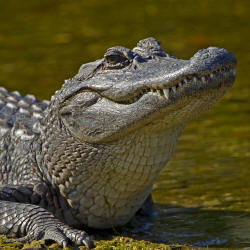World Animals
South American Animals
Green Anaconda

Animal Kingdom: Snake, Reptile
Population: N/A (really many!)
Size: W: app. 30 cm, L: 6 m - 9 m
Weight: app. 120 kg
Life Expectancy: 10 years - 30 years
Food source: Everything swallowable
Max. speed: 8 km/h
Nutritional value: Omega-3 and Omaga-5
Eunectes murinus (derived from the Greek ευνήκτης meaning "good swimmer"
and the Latin murinus meaning "of mice" for being thought to prey on
mice), commonly known as the green anaconda, is a non-venomous boa
species found in South America. It is the largest, heaviest, and second
longest (behind the reticulated python) known extant snake species. The
term anaconda (without further qualification) often refers to this
species, though the term could also apply to other members of the genus
Eunectes. Other common names include common anaconda and water boa.
The green anaconda is the world's heaviest and one of the world's
longest snakes, reaching more than 6.6 m (22 ft) long.[2] More typical
mature specimens reportedly can range up 5 m (16 ft), with the females,
at around a mean length of 4.6 m (15 ft), being generally much larger in
adulthood than the male, which averages around 3 m (9.8 ft).[3][4][5]
Weights are less well studied, though will reportedly range from 30 to
70 kg (66 to 150 lb) in an average-range adult.[6][7] It is the largest
snake native to the Americas. Although it is not as long as the
Reticulated python, Eucentes murinus is probably the heaviest extant
species of snake or squamate in the world, perhaps only rivaled by the
Komodo dragon.[8] Reports of anacondas 35–40 feet or even longer also
exist, but such claims need to be regarded with caution, as no specimens
of such lengths have ever been deposited in a museum and hard evidence
is lacking.[9] A $50,000 cash reward is offered for anyone who can catch
an anaconda 30 ft (9.1 m) or longer, but the prize has not been claimed
yet.[10] Although the reticulated python is longer, the anaconda is the
heaviest snake, with a 4.5m green anaconda having bulk comparable to a
7.4m reticulated python.[11] The longest (and heaviest) scientifically
verified specimen was a female measuring 521 cm (17.09 ft) long and
weighing 97.5 kg (215 lb).
Aligator

Animal Kingdom: Dinosaur, Reptile
Population: More than 5 millions
Size: H: Flat like a pan cake, L: app. 3.5 m
Weight: 181 kg - 363 kg
Life Expectancy: 30 years - 60 years
Food source: Any meatballs that ends up in the river
Max. speed: 24 km/h
Nutritional value: Like chicken a lot of protein
The American alligator (Alligator mississippiensis), sometimes referred
to colloquially as a gator or common alligator, is a large crocodilian
reptile endemic to the southeastern United States. It is one of two
living species in the genus Alligator within the family Alligatoridae
and larger than the other extant alligator species, the Chinese
alligator. Adult male American alligators measure 3.4 m (11 ft) to 4.6 m
(15 ft) in length, and can weigh 453 kg (999 lb). Females are smaller,
measuring around 3 m (9.8 ft). The American alligator inhabits
freshwater wetlands, such as marshes and cypress swamps from Texas to
North Carolina. It is distinguished from the sympatric American
crocodile by its broader snout, with overlapping jaws and darker
coloration, and is less tolerant of seawater but more tolerant of cooler
climates than the American crocodile which is found only in tropical
climates.
Alligators are apex predators and consume fish, amphibians, reptiles,
birds and mammals. Hatchlings feed mostly on invertebrates. Alligators
play an important role as ecosystem engineers in wetland ecosystems
through the creation of alligator holes which provide both wet and dry
habitats for other organisms. Throughout the year, but especially during
the breeding season, alligators bellow to declare territory and locate
suitable mates.[2] Male alligators use infrasound to attract females.
Eggs are laid in a nest of vegetation, sticks, leaves, and mud in a
sheltered spot in or near the water. Young are born with yellow bands
around their bodies and are protected by their mother for up to one
year.
The American alligator was first classified by French zoologist François
Marie Daudin as Crocodilus mississipiensis in 1801. Georges Cuvier
classified the genus Alligator in 1807.[4] The American alligator shares
this genus with the Chinese alligator. They are grouped in the family
Alligatoridae with the caimans. The superfamily Alligatoroidea includes
all crocodilians (fossil and extant) that are more closely related to
the American alligator than to either the Nile crocodile or the gharial.